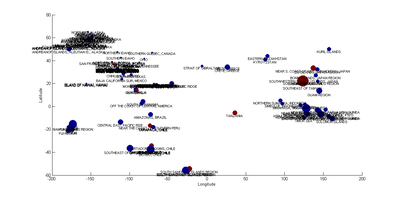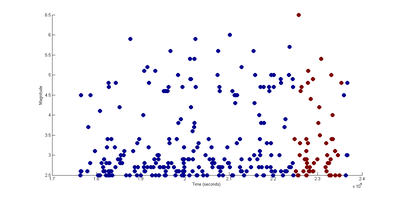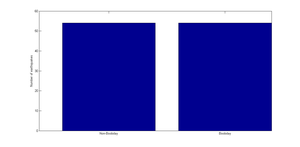April 27, 2010
Boobday statistics
Just a quick exercise with Matlab and the USGS earthquake data to check whether the boobquake experiment did produce extra earthquakes.
The answer is no.
Here are the earthquakes in the period 2010/04/20 09:57:38 to 2010/04/27 09:31:10, plotted by latitude and longitude. Boobday quakes are red (to be on the sure side I include everything on the 26th and 7 hours later, to take American local time into account).
There are some dense clusters in Alaska, southern California and the Caribbean. While I can believe immodest clothing is common in the later two, Alaska is not widely known for scantily clothed women. The biggest earthquakes were in the south-western Ryuku Islands, Indonesia, Chile and Tonga. Again, I can imagine some immodesty on tropical islands. But note that the boobday quakes are not centred around locations that are likely to have many English-speaking sceptics.
Plotting magnitude versus time gives us this plot:
There is no clear tendency for more or more intense earthquakes during boobday. Plotting the mean magnitude for the two kinds of quakes gives us this bar diagram:
Running a two-sided Wilcoxon rank sum test on the data gives p=0.7355, so it is not possible to reject the null hypothesis that there is no difference at all. So immodesty does not increase the magnitude noticeably.
Comparing the number of earthquakes over time also gives a very similar result. Here I have compared boobday with an equally long time interval starting on the 24th:
No noticeable difference. No difference at all, actually - both periods had 54 quakes. Maybe divine anger expresses itself as an increase in micro-quakes below 2.5 on the Richter scale, but that seems to be a pretty weak claim.
Hojatoleslam Kazem Sedighi's bold hypothesis that immodest female clothing increases earthquakes appears to be refuted, unless he can claim the increase in immodesty caused by the boobquake experiment was insignificant (which no doubt he will do in his follow-up paper about why Facebook sceptics cause earthquakes).
But if the experiment was too small to produce measurable divine anger, then he should perhaps consider the issue whether the ambient immodesty in different locations explains their earthquake frequency. There were after all some big quakes or quake clusters near sunny islands. However, given the well known earthquake density map he will need some pretty complex explanations.What about the dense cluster across Iran? Or the absence of quakes in Brazil? Are the mid-oceanic earthquakes due to mermaids?
April 26, 2010
A sense of proportion
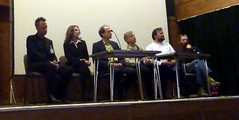 This Saturday I spoke at Humanity+ UK2010. Great fun as always when you put a lot of future oriented big thinkers in close vicinity.
This Saturday I spoke at Humanity+ UK2010. Great fun as always when you put a lot of future oriented big thinkers in close vicinity.
I think the morning session was all about complexity and adaptation: Max More explained what he was sceptical about in singularity scenarios (the core there was that most scenarios do not take into account the complexity of real socio-techo-economic systems). I talked about cognition enhancement as a way to become more adaptive and Rachel Armstrong described how synthetic life might allow a very different way of doing "biotechnology" based on carefully tuned emergent properties. The evening session covered everything from radical hedonism with David Pearce to the internet of things (David Orban) to DIY enhancement art (Natasha Vita More, of course) to posthuman perception (Amon Twyman).
One of the key ideas I took with me from the afternoon session was the need to have a sense of proportion.
 When thinking about existential risks it is important to have a sense of what the stakes are, and not just think "that is bad" - some things can be many orders of magnitude worse than others. At the same time, as Nick Bostrom pointed out, we have rather minimal research on how to prevent human extinction, about the same size as the literature on dung beetle reproduction. Toby Ord has pointed out that some charities can be up to 10,000 times more efficient in providing health than others (in terms of years of life per dollar donated), just because they focus on particular very effective means. Aubrey de Grey showed a pretty minor advance in biogerontology that was hailed in the media as "the secret of ageing", while rattling of a series of papers with far more profound implications that nobody outside the field has heard of. A graph of cost and size of carbon abatement methods clearly shows that some fix a vastly bigger chunk than others.
When thinking about existential risks it is important to have a sense of what the stakes are, and not just think "that is bad" - some things can be many orders of magnitude worse than others. At the same time, as Nick Bostrom pointed out, we have rather minimal research on how to prevent human extinction, about the same size as the literature on dung beetle reproduction. Toby Ord has pointed out that some charities can be up to 10,000 times more efficient in providing health than others (in terms of years of life per dollar donated), just because they focus on particular very effective means. Aubrey de Grey showed a pretty minor advance in biogerontology that was hailed in the media as "the secret of ageing", while rattling of a series of papers with far more profound implications that nobody outside the field has heard of. A graph of cost and size of carbon abatement methods clearly shows that some fix a vastly bigger chunk than others.
It seems to me that the vast differences in effectiveness noticed in charities, news coverage, research focus and abatement methods probably have counterparts everywhere: there are *vast* differences in importance between different things, yet this is often overlooked.
 When two things can be put side by side it often appears as if they are roughly equal, even when one of them is far more important than the other. Substitute fly ash for clinker in cement, or replace incandescent light bulbs with LEDs? Sounds about the same. Distribute condoms or mass media educate people about AIDS? Sounds about the same. Research end-of-the-world scenarios or beetles? Sounds about the same. Research arteriosclerosis or ageing? Sounds about the same. Yet in each pair one thing is at least an order of magnitude more important than the other.
When two things can be put side by side it often appears as if they are roughly equal, even when one of them is far more important than the other. Substitute fly ash for clinker in cement, or replace incandescent light bulbs with LEDs? Sounds about the same. Distribute condoms or mass media educate people about AIDS? Sounds about the same. Research end-of-the-world scenarios or beetles? Sounds about the same. Research arteriosclerosis or ageing? Sounds about the same. Yet in each pair one thing is at least an order of magnitude more important than the other.
One reason is of course that we do not have the data. It takes a bit of statistics to see that the clinker substitution and mass media education is vastly more efficient, and this kind of statistics is not always easy to get or interpret. This is why getting a better "internet of things" is so important: we can actually query a lot of the things in the world to get information about its state. It will not solve the total problem, since much of the really important information needs plenty of deeper analysis to become reliable information (just consider the climate data issues).
 Another problem is that even with data many of us do not have a sense of scale. This is where information visualisation and education are important. A visualisation of length scales (wow! gold leaf is amazingly thin!) is helpful, and if it is visually appealing it makes it easier to recall the details. I think we should ensure that there are plenty of good visualisations that give us a sense of scale, not just of length but of time, energy and value. And we should ensure that we and everybody else regularly look and learn from them.
Another problem is that even with data many of us do not have a sense of scale. This is where information visualisation and education are important. A visualisation of length scales (wow! gold leaf is amazingly thin!) is helpful, and if it is visually appealing it makes it easier to recall the details. I think we should ensure that there are plenty of good visualisations that give us a sense of scale, not just of length but of time, energy and value. And we should ensure that we and everybody else regularly look and learn from them.
As David MacKay notes, the myth that "every little helps" is quite pernicious: If everyone does a little, we’ll achieve only a little. Sometimes small individual actions do have big effects, like vaccination programs or participating in writing Wikipedia, but this is not the rule. Small efforts tend to be symbolic and make us feel we have done our part.
But there are deeper problems. How do we even judge the importance of new scientific papers? Recently there was a meeting on hard problems in social science where (among other issues) Nick suggested that one key hard problem is indeed to figure out the real worth of academic contributions. Any small improvement here would clearly have a huge impact not only on what papers we should prioritize to read, but also allocations of money and other resources, and presumably on the rate of development.
 If there are vast differences in importance between things, it also means that even small advances on an important goal may matter much more than big advances on unimportant goals. Right now designers are having great fun coming up with gadgets that signal to consumers how much energy they are using or warning us about "vampire power". Yet the biggest energy losses occur during producing and distributing power, and the big energy users are not individual consumers but things like transport and industry. If the designers instead focus on making these sectors slightly more efficient they would probably have a much bigger impact.
If there are vast differences in importance between things, it also means that even small advances on an important goal may matter much more than big advances on unimportant goals. Right now designers are having great fun coming up with gadgets that signal to consumers how much energy they are using or warning us about "vampire power". Yet the biggest energy losses occur during producing and distributing power, and the big energy users are not individual consumers but things like transport and industry. If the designers instead focus on making these sectors slightly more efficient they would probably have a much bigger impact.
Except of course that you get cred as a designer by making a gadget people can see and admire. Designers of a better coal furnace or a clever process control interface won't get invited to cool parties and art events as often, despite their greater importance. This is similar to the observation that most people do not care much about how effective the charity they donate to is, or that news stories about science prefer to focus on the new and dramatic readers might like rather than the important (case in point: the extreme media bias in the MMR scare). These social and economic biases hide the true importance of things, or direct us towards fixing less important things because they give us other, tangible rewards.
Of course, one might argue that we shouldn't be tempted by being invited to art events if we could single-handedly fix the climate slightly but significantly: the latter is so much more important than the first one. Unfortunately relatively few people are able to completely follow what they consider to be important. Social rewards and money are often more powerful motivators than the intellectual realization that A is a thousand times more important than B.
So where does this lead us? I think the conclusion is that we must really chip away at the problems of:
- Figuring out relative importance better
- Make these differences stand out more clearly
- Tune rewards to correlate more strongly with importance
- Reduce biases that make us mis-prioritize
This is a set of tremendously hard, complex and *important* problems.
But they are by no means impossible to deal with - some of the above links show information visualisations that help problem 2 and data that attack problem 1 in different domains, there are economic incentives for solving several, new findings in cognitive and social psychology have a direct bearing on them. And given the importance of the issue - since it affects nearly any domain and by definition makes us make very costly misallocations of effort - even small advances can be tremendously valuable. Besides, many of the sub-problems are quite interesting and rewarding on their own.
Did we have a sense of proportion at the Humanity+ meeting? Maybe, maybe not. But I think we were more aware than most people that the "amplitude" of the future - whether it will go well or badly - may be much bigger than most people think. We should seriously consider both the risk of going extinct and the possibilities of enhanced immortality. How good or bad could things be? How likely are different scenarios, and how can we tell whether our estimates are right? How do these estimates compare with other things? That constitutes a first few steps towards getting a *real* sense of proportion.
April 23, 2010
Distributed cognition
Anders Sandberg on Neuroselves and exoselves: distributed cognition inside and outside brains - a recording of my talk I gave on Sunday the 18th in Teleplace. Given that I had some connection problems (do not trust your wireless to handle webcasting) the quality and flow is somewhat intermittent, but hopefully at least part of my talk is comprehensible.
April 22, 2010
Free the data
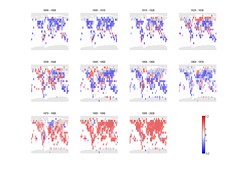 Practical Ethics: I'm a taxpayer, I want my data! - I blog about the ethics of having researchers release their data to the public. Since I think science is a fundamentally collective activity that really requires independent (and often adversarial) investigation of the same data, I am in favour of having publicly funded data be made publicly available as soon as findings get published. Yes, it might be annoying to researchers and cost some effort and side-income, but I believe the benefits actually outweigh the drawbacks.
Practical Ethics: I'm a taxpayer, I want my data! - I blog about the ethics of having researchers release their data to the public. Since I think science is a fundamentally collective activity that really requires independent (and often adversarial) investigation of the same data, I am in favour of having publicly funded data be made publicly available as soon as findings get published. Yes, it might be annoying to researchers and cost some effort and side-income, but I believe the benefits actually outweigh the drawbacks.
The real tricky part is to set the timing: clearly data should be private before publication, but become public soon after. But how soon depends on the speed of publication, which itself is a technical and economical matter that is going to change a lot in the near future. Also, multiple publications from the same dataset are common - should we wait for the slowest one, or the fastest one?
April 16, 2010
Flanders vs. Fermi
 Why We Haven't Met Any Aliens by Geoffrey Miller in Seed Magazine has a nice essay about one explanation for the Fermi paradox:
Why We Haven't Met Any Aliens by Geoffrey Miller in Seed Magazine has a nice essay about one explanation for the Fermi paradox:
Life evolves to make use of indirect cues of fitness rather than fitness itself: it is not possible to estimate fitness effects directly of objects or actions. So we evolve heuristics that link certain properties (nutritious food, healthy mates, safe environments) with pleasure (or at least, set up motivation systems that makes us pursue them), and conversely things that tend to reduce fitness with pain or aversion.
Intelligent species are good by definition of solving problems, so they solve the problem of getting whatever they want. The result is not just improvement of real fitness (as demonstrated by the 7 billion of us) but also the ability to produce fake fitness: signals that stimulate our reward systems but do not actually improve evolutionary fitness: computer games, pornography, ultra-tasty junk food, hundreds of facebook friends.
Miller argues that any species will run into the Great Temptation as it develops, creating an environment that gives the strongest fitness signals possible without actually having a real effect on fitness. Once you can have perfect sex with an android partner, play totally engrossing VR games and avoid experiencing any suffering, why should you care about the rest of the universe? The end result, Miller thinks, is that alien species mostly go extinct because they allocate too much resources on pleasure and too little on their fitness.
I think the Great Temptation model is true: technology aims at making a magical world where desires become safe reality, and it (together with culture) can provide an endless distractions. But to work for the Fermi paradox the temptation needs to be very strong: it needs to get any alien species, regardless of whether they are eusocial scorpions, intelligent slime molds or floating brains in a brown dward atmosphere. All the species need to be unable to resist the temptation of building the experience machine and tune in. Not only that, it has to be every individual too.
Miller points out that some individuals - for various reasons - will resist the temptation and may form lineages where there is evolutionary selection for resisting temptation. He suggests the future belongs to hard-working, child-rearing, green religious beings - the Flanders families of the universe. In the long run our xbox-avoiding descendants will meet the alien serious super-parents.
But it seems that this addition breaks the Great Temptation as an explanation of the Fermi paradox. If intelligence just partially succumbs to the Great Temptation, then we should expect to see a lot of Flanders civilizations out there. And given the evolutionary pressure towards greater fitness, they might be less timid neighbours than voracious locust swarms - Robin Hanson's "burning the cosmic commons" model seems to apply here with full strength. If species always lack the coordination or foresight to avoid temptation but they can evolve to resist it, then it would seem that they can also evolve towards total fitness-maximizers in the interstellar environment (Homers?) and there would be no foresight/coordination strong enough to stop this process.
So the Great Temptation explanation seems to require a strong convergence hypothesis: all species develop technologies that entice them to turn inward, and subgroups that can resist that pull will (in time) develop something else that will catch them. Eventually everybody ends up trapped (but happy).
April 08, 2010
Zoom into the Mercator Mandelbrot
Makc just made a flash Mandelbrot zoomer using my Mercator Mandelbrot images. This is a cool hack; since the zoom is precomputed it is fast, and now the set has gone from Cartesian to polar to Cartesian again. There is blurring, but since the central part stays sharp this isn't bothersome.
April 06, 2010
Ethicists analysing ethicists analysing themselves
 Practical Ethics: Experience and self-experimentation in ethics - an essay where I consider whether the fact that I have used cognition enhancers renders me more or less suitable to discuss their ethics.
Practical Ethics: Experience and self-experimentation in ethics - an essay where I consider whether the fact that I have used cognition enhancers renders me more or less suitable to discuss their ethics.
My view is that bias cannot be avoided, but at least some kinds of research or discourse can correct for it well enough. In ethics an argument is fairly open to criticism, so bias is much easier to correct than if the argument is based on hidden data, assumptions and methods that require significant resources to uncover or replicate (e.g. the case in much experimental science). This means that arguments are fairly independent of who made them, their biases and their possible lack of morals. It doesn't matter except biographically if a line of reasoning was made by a naturally clever person, a not-so clever person taking an enhancer, by an idiot out of dumb luck or the devil seeking a particular manipulative end: the reasoning stands on its own.
Of course, the whole essay is a bizarre self-referential apologism: I am writing about the ethics of ethicists using substances they are studying the ethics of using while being one such ethicist, and then I start analysing the ethics of this situation. This paragraph notices the slight ethical queasiness I feel about the whole recursion, yet if my basic argument above is right this at most amounts to a few fractal embellishments on top of an argument that should be valid regardless. I did pick up a book by Douglas Hofstadter earlier today, maybe I caught something from it. :-)
